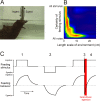State dependence of network output: modeling and experiments
- PMID: 19005044
- PMCID: PMC2628437
- DOI: 10.1523/JNEUROSCI.3796-08.2008
State dependence of network output: modeling and experiments
Abstract
Emerging experimental evidence suggests that both networks and their component neurons respond to similar inputs differently, depending on the state of network activity. The network state is determined by the intrinsic dynamical structure of the network and may change as a function of neuromodulation, the balance or stochasticity of synaptic inputs to the network, and the history of network activity. Much of the knowledge on state-dependent effects comes from comparisons of awake and sleep states of the mammalian brain. Yet, the mechanisms underlying these states are difficult to unravel. Several vertebrate and invertebrate studies have elucidated cellular and synaptic mechanisms of state dependence resulting from neuromodulation, sensory input, and experience. Recent studies have combined modeling and experiments to examine the computational principles that emerge when network state is taken into account; these studies are highlighted in this article. We discuss these principles in a variety of systems (mammalian, crustacean, and mollusk) to demonstrate the unifying theme of state dependence of network output.
Figures



Similar articles
-
The roles of co-transmission in neural network modulation.Trends Neurosci. 2001 Mar;24(3):146-54. doi: 10.1016/s0166-2236(00)01723-9. Trends Neurosci. 2001. PMID: 11182454 Review.
-
Multisensory integration: psychophysics, neurophysiology, and computation.Curr Opin Neurobiol. 2009 Aug;19(4):452-8. doi: 10.1016/j.conb.2009.06.008. Epub 2009 Jul 16. Curr Opin Neurobiol. 2009. PMID: 19616425 Free PMC article.
-
Effects of cellular homeostatic intrinsic plasticity on dynamical and computational properties of biological recurrent neural networks.J Neurosci. 2013 Sep 18;33(38):15032-43. doi: 10.1523/JNEUROSCI.0870-13.2013. J Neurosci. 2013. PMID: 24048833 Free PMC article.
-
Homeostatic Activity-Dependent Tuning of Recurrent Networks for Robust Propagation of Activity.J Neurosci. 2016 Mar 30;36(13):3722-34. doi: 10.1523/JNEUROSCI.2511-15.2016. J Neurosci. 2016. PMID: 27030758 Free PMC article.
-
Neuromodulation of vertebrate locomotor control networks.Physiology (Bethesda). 2011 Dec;26(6):393-411. doi: 10.1152/physiol.00013.2011. Physiology (Bethesda). 2011. PMID: 22170958 Review.
Cited by
-
Chapter 3--networks within networks: the neuronal control of breathing.Prog Brain Res. 2011;188:31-50. doi: 10.1016/B978-0-444-53825-3.00008-5. Prog Brain Res. 2011. PMID: 21333801 Free PMC article. Review.
-
Removal of default state-associated inhibition during repetition priming improves response articulation.J Neurosci. 2012 Dec 5;32(49):17740-52. doi: 10.1523/JNEUROSCI.4137-12.2012. J Neurosci. 2012. PMID: 23223294 Free PMC article.
-
High prevalence of multistability of rest states and bursting in a database of a model neuron.PLoS Comput Biol. 2013;9(3):e1002930. doi: 10.1371/journal.pcbi.1002930. Epub 2013 Mar 7. PLoS Comput Biol. 2013. PMID: 23505348 Free PMC article.
-
State-dependent interactions between excitatory neuromodulators in the neuronal control of breathing.J Neurosci. 2010 Jun 16;30(24):8251-62. doi: 10.1523/JNEUROSCI.5361-09.2010. J Neurosci. 2010. PMID: 20554877 Free PMC article.
-
Decomposing Neural Circuit Function into Information Processing Primitives.J Neurosci. 2024 Jan 10;44(2):e0157232023. doi: 10.1523/JNEUROSCI.0157-23.2023. J Neurosci. 2024. PMID: 38050070 Free PMC article.
References
-
- Alitto HJ, Usrey WM. Corticothalamic feedback and sensory processing. Curr Opin Neurobiol. 2003;13:440–445. - PubMed
-
- Bédard C, Kröger H, Destexhe A. Does the 1/f frequency scaling of brain signals reflect self-organized critical states? Phys Rev Lett. 2006;97:118102. - PubMed
-
- Beer RD. A dynamical systems perspective on agent-environment interactoin. Artif Intel. 1995;72:173–215.
Publication types
MeSH terms
Grants and funding
LinkOut - more resources
Full Text Sources
